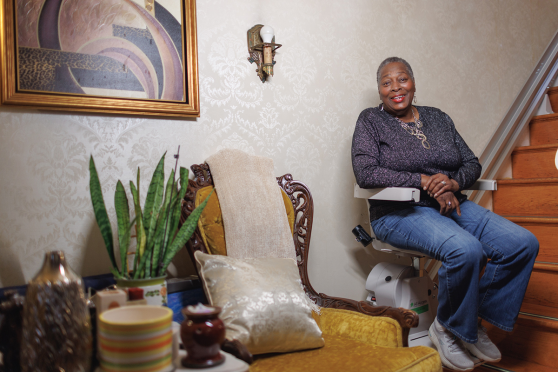Tips for making the most of your CPAP device
Your top tool in managing sleep apnea? A CPAP device. Here’s how to use (and care for) it correctly.

Gasping for air in the middle of the night? Feeling groggy throughout the day? Moving from one sleep aid to the next—with minimal results? You may be struggling with sleep apnea, a condition that causes some folks to stop breathing during sleep, depriving your body of a good night's rest.
That is, unless you have a continuous positive airway pressure (CPAP) device.
When used correctly, CPAP therapy is an effective treatment for a diagnosis of obstructive sleep apnea. Unfortunately, CPAP therapy can also be challenging. That’s because the equipment used can seem contrary to a comfortable night's sleep. Users must wear a mask, which can sometimes cause skin irritation, dry mouth, or other discomforts. As a result, roughly 50 percent of CPAP users abandon it during the first year of therapy, according to research.
But to overcome these obstacles—and finally start getting restful sleep—according to experts, all you need is to know the ins and outs of your device. Start with these tips.
1. Find the right pressure
When you start using a CPAP device, your doctor will tell you how much air pressure you need to control your condition. However, you may find that the air pressure level doesn’t work for you.
When the pressure is too high, you may experience gas and bloating, headaches, dry mouth and throat, and excessive fatigue. If the pressure is too low, your sleep apnea won’t be alleviated.
Contact your doctor if you experience any of these symptoms, or if you switch to another manufacturer or have any questions about your device. “We can work with patients to make sure they’re getting a comfortable delivery of air,” says Sigrid C. Veasey, M.D., a sleep medicine physician at Penn Sleep Center Market Street in Philadelphia.
2. Find the right fit
Finding a CPAP mask that meets your needs can make a world of difference as far as comfort goes, according to Dr. Veasey.
Many different types of CPAP masks include minimalist styles that fit under the nose, full-face variations that cover both the nose and mouth, and options in between. If you’re claustrophobic, or if you want a full field of vision for reading or watching TV, you might prefer a minimalist style. Try a nasal pillow mask (which uses a stretchy strap around the back of your head and a cushiony seal to increase comfort). But if you have a hard time breathing through your nose, or you tend to be a mouth-breather when you sleep, you might do better with a full-face style that supplies air to your nose and mouth.
Bottom line: If you’re not happy with your mask, you can easily swap it out for a different one. Masks are usually initially fitted by the specialist who comes to the home with the equipment. Your doctor or CPAP provider can help equip you with new masks to try until you find one you like.
3. Fix leaky masks
If your mask is noisy or you wake up with dry eyes, your mask might be leaking air.
You can try tightening your mask a little, but be careful not to tighten it too much, as this can make leaks worse. “If it’s too tight, there’s not enough of an air cushion to really cover every nook and cranny in the face,” Dr. Veasey says. As a result, air can escape.
If tightening the mask doesn’t solve your leak, you may need a different mask size or shape. “We all have very different faces,” Dr. Veasey says. The size and shape of the nose, cheekbones, and other facial features can make a difference in how a mask fits one person versus another, she says. Your best bet is to troubleshoot with your doctor or CPAP provider to see if you need a different one.
You’ll know your mask fits well if you can exhale comfortably through your nose without leaking any air, Dr. Veasey says.
4. Keep everything clean
To ensure that your CPAP mask and device keep delivering benefits, clean everything regularly.
While your doctor or CPAP provider will instruct you on the best way to clean your mask, Dr. Veasey recommends that her patients use gentle soap and water to wipe the inside of theirs. Then, she says, flush out the tubing every couple of days by combining 1 cup of water and ¼ cup of white vinegar. “Just make sure you rinse it out after, so you don’t smell vinegar at night,” Dr. Veasey adds. You can also use a bit of the water and vinegar to wipe off any dust or debris in the humidifier tray.
Another important step: Swap out the air filter on a regular basis. How often you change it will depend on how much dust is in your home, but most people replace them every two to four weeks, Dr. Veasey says.
Finally, protect your mask’s lining, which is often made of thin, delicate materials that deteriorate over time. “They will deteriorate more quickly if patients have any oils or makeup on their faces,” Dr. Veasey says. Wash your face with gentle soap and water and dry your skin thoroughly before putting on your mask at night.
5. Resolve skin troubles
CPAP masks tend to be gentle on the skin, but some people do encounter skin issues when wearing them, according to Dr. Veasey.
For example, some people wake up with a skin rash from their mask straps. This can happen if you’re a side sleeper and the strap rubs against your cheek during the night. Dr. Veasey suggests placing moleskin fabric under the straps to create a cushion.
Other people get a rash under the mask. If this happens to you, try using an absorbent cotton liner under the mask, Dr. Veasey says.
However, if you wake up with a skin rash from the mask itself, it’s time to do some adjusting. “You should not end up with red marks over the nose or mouth,” Dr. Veasey says. If you do, your best bet is to make a virtual or in-person appointment with your doctor, so that he or she can do some troubleshooting.



